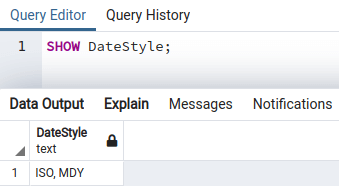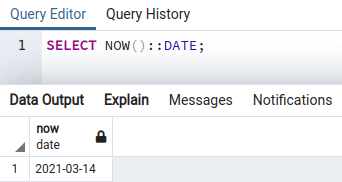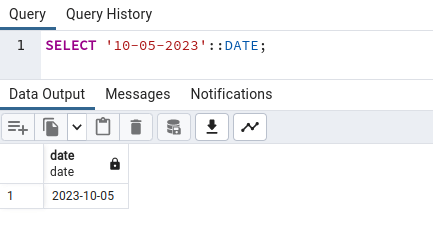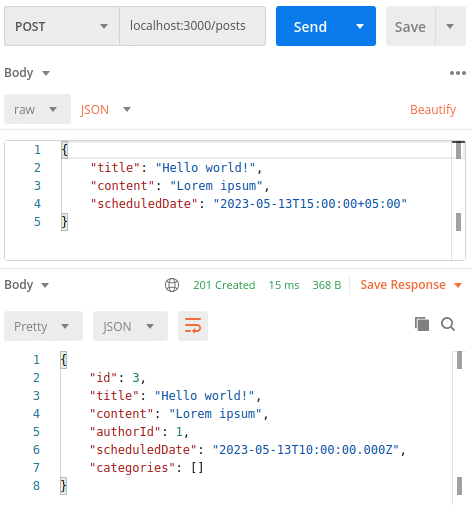- 1. API with NestJS #1. Controllers, routing and the module structure
- 2. API with NestJS #2. Setting up a PostgreSQL database with TypeORM
- 3. API with NestJS #3. Authenticating users with bcrypt, Passport, JWT, and cookies
- 4. API with NestJS #4. Error handling and data validation
- 5. API with NestJS #5. Serializing the response with interceptors
- 6. API with NestJS #6. Looking into dependency injection and modules
- 7. API with NestJS #7. Creating relationships with Postgres and TypeORM
- 8. API with NestJS #8. Writing unit tests
- 9. API with NestJS #9. Testing services and controllers with integration tests
- 10. API with NestJS #10. Uploading public files to Amazon S3
- 11. API with NestJS #11. Managing private files with Amazon S3
- 12. API with NestJS #12. Introduction to Elasticsearch
- 13. API with NestJS #13. Implementing refresh tokens using JWT
- 14. API with NestJS #14. Improving performance of our Postgres database with indexes
- 15. API with NestJS #15. Defining transactions with PostgreSQL and TypeORM
- 16. API with NestJS #16. Using the array data type with PostgreSQL and TypeORM
- 17. API with NestJS #17. Offset and keyset pagination with PostgreSQL and TypeORM
- 18. API with NestJS #18. Exploring the idea of microservices
- 19. API with NestJS #19. Using RabbitMQ to communicate with microservices
- 20. API with NestJS #20. Communicating with microservices using the gRPC framework
- 21. API with NestJS #21. An introduction to CQRS
- 22. API with NestJS #22. Storing JSON with PostgreSQL and TypeORM
- 23. API with NestJS #23. Implementing in-memory cache to increase the performance
- 24. API with NestJS #24. Cache with Redis. Running the app in a Node.js cluster
- 25. API with NestJS #25. Sending scheduled emails with cron and Nodemailer
- 26. API with NestJS #26. Real-time chat with WebSockets
- 27. API with NestJS #27. Introduction to GraphQL. Queries, mutations, and authentication
- 28. API with NestJS #28. Dealing in the N + 1 problem in GraphQL
- 29. API with NestJS #29. Real-time updates with GraphQL subscriptions
- 30. API with NestJS #30. Scalar types in GraphQL
- 31. API with NestJS #31. Two-factor authentication
- 32. API with NestJS #32. Introduction to Prisma with PostgreSQL
- 33. API with NestJS #33. Managing PostgreSQL relationships with Prisma
- 34. API with NestJS #34. Handling CPU-intensive tasks with queues
- 35. API with NestJS #35. Using server-side sessions instead of JSON Web Tokens
- 36. API with NestJS #36. Introduction to Stripe with React
- 37. API with NestJS #37. Using Stripe to save credit cards for future use
- 38. API with NestJS #38. Setting up recurring payments via subscriptions with Stripe
- 39. API with NestJS #39. Reacting to Stripe events with webhooks
- 40. API with NestJS #40. Confirming the email address
- 41. API with NestJS #41. Verifying phone numbers and sending SMS messages with Twilio
- 42. API with NestJS #42. Authenticating users with Google
- 43. API with NestJS #43. Introduction to MongoDB
- 44. API with NestJS #44. Implementing relationships with MongoDB
- 45. API with NestJS #45. Virtual properties with MongoDB and Mongoose
- 46. API with NestJS #46. Managing transactions with MongoDB and Mongoose
- 47. API with NestJS #47. Implementing pagination with MongoDB and Mongoose
- 48. API with NestJS #48. Definining indexes with MongoDB and Mongoose
- 49. API with NestJS #49. Updating with PUT and PATCH with MongoDB and Mongoose
- 50. API with NestJS #50. Introduction to logging with the built-in logger and TypeORM
- 51. API with NestJS #51. Health checks with Terminus and Datadog
- 52. API with NestJS #52. Generating documentation with Compodoc and JSDoc
- 53. API with NestJS #53. Implementing soft deletes with PostgreSQL and TypeORM
- 54. API with NestJS #54. Storing files inside a PostgreSQL database
- 55. API with NestJS #55. Uploading files to the server
- 56. API with NestJS #56. Authorization with roles and claims
- 57. API with NestJS #57. Composing classes with the mixin pattern
- 58. API with NestJS #58. Using ETag to implement cache and save bandwidth
- 59. API with NestJS #59. Introduction to a monorepo with Lerna and Yarn workspaces
- 60. API with NestJS #60. The OpenAPI specification and Swagger
- 61. API with NestJS #61. Dealing with circular dependencies
- 62. API with NestJS #62. Introduction to MikroORM with PostgreSQL
- 63. API with NestJS #63. Relationships with PostgreSQL and MikroORM
- 64. API with NestJS #64. Transactions with PostgreSQL and MikroORM
- 65. API with NestJS #65. Implementing soft deletes using MikroORM and filters
- 66. API with NestJS #66. Improving PostgreSQL performance with indexes using MikroORM
- 67. API with NestJS #67. Migrating to TypeORM 0.3
- 68. API with NestJS #68. Interacting with the application through REPL
- 69. API with NestJS #69. Database migrations with TypeORM
- 70. API with NestJS #70. Defining dynamic modules
- 71. API with NestJS #71. Introduction to feature flags
- 72. API with NestJS #72. Working with PostgreSQL using raw SQL queries
- 73. API with NestJS #73. One-to-one relationships with raw SQL queries
- 74. API with NestJS #74. Designing many-to-one relationships using raw SQL queries
- 75. API with NestJS #75. Many-to-many relationships using raw SQL queries
- 76. API with NestJS #76. Working with transactions using raw SQL queries
- 77. API with NestJS #77. Offset and keyset pagination with raw SQL queries
- 78. API with NestJS #78. Generating statistics using aggregate functions in raw SQL
- 79. API with NestJS #79. Implementing searching with pattern matching and raw SQL
- 80. API with NestJS #80. Updating entities with PUT and PATCH using raw SQL queries
- 81. API with NestJS #81. Soft deletes with raw SQL queries
- 82. API with NestJS #82. Introduction to indexes with raw SQL queries
- 83. API with NestJS #83. Text search with tsvector and raw SQL
- 84. API with NestJS #84. Implementing filtering using subqueries with raw SQL
- 85. API with NestJS #85. Defining constraints with raw SQL
- 86. API with NestJS #86. Logging with the built-in logger when using raw SQL
- 87. API with NestJS #87. Writing unit tests in a project with raw SQL
- 88. API with NestJS #88. Testing a project with raw SQL using integration tests
- 89. API with NestJS #89. Replacing Express with Fastify
- 90. API with NestJS #90. Using various types of SQL joins
- 91. API with NestJS #91. Dockerizing a NestJS API with Docker Compose
- 92. API with NestJS #92. Increasing the developer experience with Docker Compose
- 93. API with NestJS #93. Deploying a NestJS app with Amazon ECS and RDS
- 94. API with NestJS #94. Deploying multiple instances on AWS with a load balancer
- 95. API with NestJS #95. CI/CD with Amazon ECS and GitHub Actions
- 96. API with NestJS #96. Running unit tests with CI/CD and GitHub Actions
- 97. API with NestJS #97. Introduction to managing logs with Amazon CloudWatch
- 98. API with NestJS #98. Health checks with Terminus and Amazon ECS
- 99. API with NestJS #99. Scaling the number of application instances with Amazon ECS
- 100. API with NestJS #100. The HTTPS protocol with Route 53 and AWS Certificate Manager
- 101. API with NestJS #101. Managing sensitive data using the AWS Secrets Manager
- 102. API with NestJS #102. Writing unit tests with Prisma
- 103. API with NestJS #103. Integration tests with Prisma
- 104. API with NestJS #104. Writing transactions with Prisma
- 105. API with NestJS #105. Implementing soft deletes with Prisma and middleware
- 106. API with NestJS #106. Improving performance through indexes with Prisma
- 107. API with NestJS #107. Offset and keyset pagination with Prisma
- 108. API with NestJS #108. Date and time with Prisma and PostgreSQL
- 109. API with NestJS #109. Arrays with PostgreSQL and Prisma
- 110. API with NestJS #110. Managing JSON data with PostgreSQL and Prisma
- 111. API with NestJS #111. Constraints with PostgreSQL and Prisma
- 112. API with NestJS #112. Serializing the response with Prisma
- 113. API with NestJS #113. Logging with Prisma
- 114. API with NestJS #114. Modifying data using PUT and PATCH methods with Prisma
- 115. API with NestJS #115. Database migrations with Prisma
- 116. API with NestJS #116. REST API versioning
- 117. API with NestJS #117. CORS – Cross-Origin Resource Sharing
- 118. API with NestJS #118. Uploading and streaming videos
- 119. API with NestJS #119. Type-safe SQL queries with Kysely and PostgreSQL
- 120. API with NestJS #120. One-to-one relationships with the Kysely query builder
- 121. API with NestJS #121. Many-to-one relationships with PostgreSQL and Kysely
- 122. API with NestJS #122. Many-to-many relationships with Kysely and PostgreSQL
- 123. API with NestJS #123. SQL transactions with Kysely
- 124. API with NestJS #124. Handling SQL constraints with Kysely
- 125. API with NestJS #125. Offset and keyset pagination with Kysely
- 126. API with NestJS #126. Improving the database performance with indexes and Kysely
- 127. API with NestJS #127. Arrays with PostgreSQL and Kysely
- 128. API with NestJS #128. Managing JSON data with PostgreSQL and Kysely
- 129. API with NestJS #129. Implementing soft deletes with SQL and Kysely
- 130. API with NestJS #130. Avoiding storing sensitive information in API logs
- 131. API with NestJS #131. Unit tests with PostgreSQL and Kysely
- 132. API with NestJS #132. Handling date and time in PostgreSQL with Kysely
- 133. API with NestJS #133. Introducing database normalization with PostgreSQL and Prisma
- 134. API with NestJS #134. Aggregating statistics with PostgreSQL and Prisma
- 135. API with NestJS #135. Referential actions and foreign keys in PostgreSQL with Prisma
- 136. API with NestJS #136. Raw SQL queries with Prisma and PostgreSQL range types
- 137. API with NestJS #137. Recursive relationships with Prisma and PostgreSQL
- 138. API with NestJS #138. Filtering records with Prisma
- 139. API with NestJS #139. Using UUID as primary keys with Prisma and PostgreSQL
- 140. API with NestJS #140. Using multiple PostgreSQL schemas with Prisma
- 141. API with NestJS #141. Getting distinct records with Prisma and PostgreSQL
- 142. API with NestJS #142. A video chat with WebRTC and React
- 143. API with NestJS #143. Optimizing queries with views using PostgreSQL and Kysely
- 144. API with NestJS #144. Creating CLI applications with the Nest Commander
- 145. API with NestJS #145. Securing applications with Helmet
- 146. API with NestJS #146. Polymorphic associations with PostgreSQL and Prisma
- 147. API with NestJS #147. The data types to store money with PostgreSQL and Prisma
- 148. API with NestJS #148. Understanding the injection scopes
- 149. API with NestJS #149. Introduction to the Drizzle ORM with PostgreSQL
- 150. API with NestJS #150. One-to-one relationships with the Drizzle ORM
- 151. API with NestJS #151. Implementing many-to-one relationships with Drizzle ORM
- 152. API with NestJS #152. SQL constraints with the Drizzle ORM
- 153. API with NestJS #153. SQL transactions with the Drizzle ORM
- 154. API with NestJS #154. Many-to-many relationships with Drizzle ORM and PostgreSQL
- 155. API with NestJS #155. Offset and keyset pagination with the Drizzle ORM
- 156. API with NestJS #156. Arrays with PostgreSQL and the Drizzle ORM
- 157. API with NestJS #157. Handling JSON data with PostgreSQL and the Drizzle ORM
- 158. API with NestJS #158. Soft deletes with the Drizzle ORM
- 159. API with NestJS #159. Date and time with PostgreSQL and the Drizzle ORM
- 160. API with NestJS #160. Using views with the Drizzle ORM and PostgreSQL
- 161. API with NestJS #161. Generated columns with the Drizzle ORM and PostgreSQL
- 162. API with NestJS #162. Identity columns with the Drizzle ORM and PostgreSQL
- 163. API with NestJS #163. Full-text search with the Drizzle ORM and PostgreSQL
- 164. API with NestJS #164. Improving the performance with indexes using Drizzle ORM
- 165. API with NestJS #165. Time intervals with the Drizzle ORM and PostgreSQL
- 166. API with NestJS #166. Logging with the Drizzle ORM
- 167. API with NestJS #167. Unit tests with the Drizzle ORM
- 168. API with NestJS #168. Integration tests with the Drizzle ORM
- 169. API with NestJS #169. Unique IDs with UUIDs using Drizzle ORM and PostgreSQL
- 170. API with NestJS #170. Polymorphic associations with PostgreSQL and Drizzle ORM
- 171. API with NestJS #171. Recursive relationships with Drizzle ORM and PostgreSQL
- 172. API with NestJS #172. Database normalization with Drizzle ORM and PostgreSQL
- 173. API with NestJS #173. Storing money with Drizzle ORM and PostgreSQL
- 174. API with NestJS #174. Multiple PostgreSQL schemas with Drizzle ORM
- 175. API with NestJS #175. PUT and PATCH requests with PostgreSQL and Drizzle ORM
- 176. API with NestJS #176. Database migrations with the Drizzle ORM
- 177. API with NestJS #177. Response serialization with the Drizzle ORM
- 178. API with NestJS #178. Storing files inside of a PostgreSQL database with Drizzle
- 179. API with NestJS #179. Pattern matching search with Drizzle ORM and PostgreSQL
- 180. API with NestJS #180. Organizing Drizzle ORM schema with PostgreSQL
- 181. API with NestJS #181. Prepared statements in PostgreSQL with Drizzle ORM
- 182. API with NestJS #182. Storing coordinates in PostgreSQL with Drizzle ORM
- 183. API with NestJS #183. Distance and radius in PostgreSQL with Drizzle ORM
- 184. API with NestJS #184. Storing PostGIS Polygons in PostgreSQL with Drizzle ORM
- 185. API with NestJS #185. Operations with PostGIS Polygons in PostgreSQL and Drizzle
- 186. API with NestJS #186. What’s new in Express 5?
- 187. API with NestJS #187. Rate limiting using Throttler
Storing date and time in our database might be tricky, but it is essential to get it right. In this article, we tackle this issue using PostgreSQL and Prisma. We also learn the concept of timezones and how to deal with them when designing our database.
How PostgreSQL interprets dates
We can learn how our database represents dates by reading the DateStyle parameter.

The result of the above query consists of two parts:
- the default date/time output
- how to interpret the input.
By default, PostgreSQL represents the dates using the ISO 8601 standard. Because of that, the default display format is YYYY-MM-DD.

In the DateStyle parameter, we can see that by default, PostgreSQL interprets provided dates as month-day-year (MDY).

Since the input format is set to MDY, the first number is treated as a month and the second as a day. Not taking it into account could result in an error when inputting our data.

When the input format is set to MDY, we could also use YYYY-MM-DD as our input.

The default DateStyle is set to ISO, MDY. However, therte are other possibilities. For more, check out the official documentation.
Basic columns built into PostgreSQL to manage dates
There are quite a few different column types we can choose to describe the date and the time.
DATE
The most basic type we can use is the DATE.
|
1 |
ALTER TABLE "Post" ADD COLUMN "createdAt" DATE NOT NULL; |
To add this column, we need to modify our schema by adding a parameter with the DateTime marked with @db.Date.
postSchema.prisma
|
1 2 3 4 5 6 7 8 9 10 11 12 |
model Post { id Int @id @default(autoincrement()) title String content String author User @relation(fields: [authorId], references: [id]) authorId Int categories Category[] createdAt DateTime @db.Date @@index([authorId]) } |
This straightforward type allows us to store a particular date without the time.
TIME
To store the time alone, we can use the TIME data type.
|
1 |
ALTER TABLE "Post" ADD COLUMN "createdAt" TIME NOT NULL; |
To add this column with Prisma, we need to add a parameter marked with @db.Time.
postSchema.prisma
|
1 2 3 4 5 6 7 8 9 10 11 12 |
model Post { id Int @id @default(autoincrement()) title String content String author User @relation(fields: [authorId], references: [id]) authorId Int categories Category[] createdAt DateTime @db.Time @@index([authorId]) } |
It represents time with hours, minutes, and seconds that include a fractional value.

TIMESTAMP
Another column worth mentioning is the TIMESTAMP.
|
1 |
ALTER TABLE "Post" ADD COLUMN "createdAt" TIMESTAMP NOT NULL; |
To configure it in our schema, we need to mark our property with @db.Timestamp.
postSchema.prisma
|
1 2 3 4 5 6 7 8 9 10 11 12 |
model Post { id Int @id @default(autoincrement()) title String content String author User @relation(fields: [authorId], references: [id]) authorId Int categories Category[] createdAt DateTime @db.Timestamp @@index([authorId]) } |
PostgreSQL stores the timestamp as a number representing a particular moment in time. The way it is displayed can be affected by the DateStyle parameter. Because the default setting is ISO, MDY, PostgreSQL shows the date in the ISO format.

Timezones
The coordinated universal time (UTC) is the primary time standard used worldwide and is defined by atomic clocks. Timezones are most often defined by the difference in hours from the UTC. A good example is Eastern Standard Time (EST) which can be described as UTC -5. If the current UTC is 20:00, the time in New York would be 15:00.
Having to deal with timezones can be a reason for quite a headache. Timezones depend on geography and politics and can be affected by daylight saving changes. This video gives an excellent summary of different aspects to consider.
When we used the TIME and TIMESTAMP types so far in this article, PostgreSQL did no timezone-related conversions. Therefore, when we enter a particular date into our database, it will always stay the same regardless of what timezone we display it in later.
The above two types have their versions that consider the timezone. When we use the TIMESTAMPTZ data type, we specify the timezone when providing the data. PostgreSQL then converts our input and stores it as UTC.

Since we provide a timestamp marked as Eastern Standard Time, PostgreSQL would add 5 hours before storing it. Thanks to that, even if we input data using various timezones, our database is consistent, and our time is not mismatched.
|
1 |
ALTER TABLE "Post" ADD COLUMN "scheduledDate" TIMESTAMPTZ; |
The TIMETZ type that is the time with timezone is discouraged by the official PostgreSQL documentation. Without the information about the date it would be impossible to account for the daylight-saving time.
To use the TIMESTAMPTZ type with Prisma, we need to mark our property with @db.Timestamptz.
postSchema.prisma
|
1 2 3 4 5 6 7 8 9 10 11 12 |
model Post { id Int @id @default(autoincrement()) title String content String author User @relation(fields: [authorId], references: [id]) authorId Int categories Category[] scheduledDate DateTime @db.Timestamptz @@index([authorId]) } |
Handling the dates in NestJS
When our users provide data, we must ensure it is valid. To do that, we can use the class-validator library. Prisma accepts the data either as the Date class built into JavaScript or as an ISO string. Since that is the case, let’s force the users to provide ISO strings.
createPost.dto.ts
|
1 2 3 4 5 6 7 8 9 10 11 12 13 14 15 16 17 18 19 20 21 22 23 24 25 26 27 |
import { IsString, IsNotEmpty, IsNumber, IsOptional, IsISO8601, } from 'class-validator'; export class CreatePostDto { @IsString() @IsNotEmpty() title: string; @IsString() @IsNotEmpty() content: string; @IsOptional() @IsNumber({}, { each: true }) categoryIds?: number[]; @IsISO8601({ strict: true, }) @IsOptional() scheduledDate?: string; } |
The strict parameter makes sure that the provided date is valid in terms of leap days, for example.
We now need to use the new property when creating our entity.
|
1 2 3 4 5 6 7 8 9 10 11 12 13 14 15 16 17 18 19 20 21 22 23 24 |
async createPost(post: CreatePostDto, user: User) { const categories = post.categoryIds?.map((category) => ({ id: category, })); return this.prismaService.post.create({ data: { title: post.title, content: post.content, scheduledDate: post.scheduledDate, author: { connect: { id: user.id, }, }, categories: { connect: categories, }, }, include: { categories: true, }, }); } |
Thanks to all of the above, we can now make a POST request that includes a date.

It’s also important to know that when we query our data from the database, Prisma converts it to instances of the Date class.
|
1 2 3 4 5 6 7 8 9 10 11 12 |
async getPostById(id: number) { const post = await this.prismaService.post.findUnique({ where: { id, }, }); if (!post) { throw new PostNotFoundException(id); } console.log(post.scheduledDate instanceof Date); // true return post; } |
Providing default values
Prisma can handle some dates for us automatically. By adding @default(now()) to our date, we ensure that Prisma provides the current date and time when the entity is created.
|
1 |
createdAt DateTime @default(now()) @db.Timestamptz |
When we do the above, Prisma generates a migration that uses the CURRENT_TIMESTAMP value provided by PostgreSQL.
|
1 |
ALTER TABLE "Post" ADD COLUMN "createdAt" TIMESTAMPTZ NOT NULL DEFAULT CURRENT_TIMESTAMP; |
Besides the creation time, PostgreSQL can also handle the time when the record was last updated. To do this, we need to mark our property with @updatedAt.
|
1 |
updatedAt DateTime @updatedAt @db.Timestamptz |
When we do the above, Prisma automatically sets the value for this field whenever we update the entity.
Summary
In this article, we’ve gone through various ways of storing the date and time with PostgreSQL. We’ve also learned how to use Prisma to define multiple types of date-related columns in our schema. On top of that, we managed to handle dates in our NestJS application.
The timezones can be the cause of various bugs and issues. Thanks to using the timestamp with timezone type available in PostgreSQL, we can ensure that our data is consistent regardless of what timezones our users are providing the data in.
